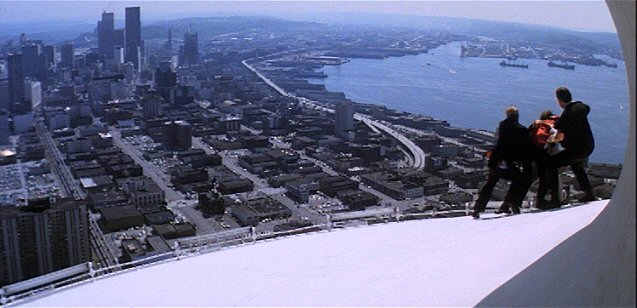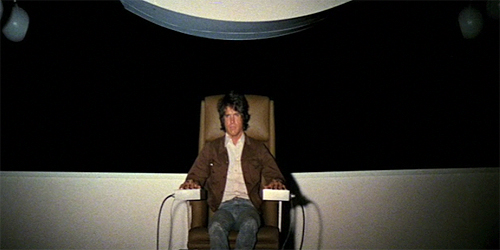Reviews of Classic Movies: 'The Parallax View'
When you go to the movies, how “realistic” do you want them to be? Very often, it depends on your mood – you may be looking for an implausible, escapist adventure, or you may want a searing commentary on life. In either case, I think we can agree that almost all movies smooth over things in favour of wrapping up the story, usually in two hours or less. And as everyone knows, real life is a lot messier and more unresolved than a Hollywood screenplay.
We can fall into a rabbit hole very easily here: how often should movies try to be more lifelike? If more movies ended with unanswered questions or heroes failing their missions, would it make them better or worse?
I’m hesitant to take these questions too far, as it might give away too much about a movie like The Parallax View, released in 1974 and directed by Alan J. Pakula. That’s because one of the things that sticks with you after watching the film is its ending – it’s not particularly shocking, or even that satisfying, but it feels so weirdly plausible (if you allow for the existence of a secret assassination company) that the movie becomes noteworthy for the sheer cynicism of its closing scene.
The film is the lesser-known companion to two of Pakula’s more well-known (and lauded) movies, Klute and All the President’s Men. Together, the movies form a loose “Political Paranoia” trilogy, and helped define a sub-genre of 70s filmmaking that played off an emerging mistrust of the government by the American people.
Admittedly, The Parallax View didn’t rise to the heights of 1976’s All the President’s Men (which netted four Oscars, including Best Adapted Screenplay). Still, it’s a rather fitting film to return to now, amid last year’s NSA revelations and other government scandals, not to mention the strong references to 70s political thrillers in new films like Captain America: The Winter Soldier. And if Marvel’s writers are savvy enough to make those connections, it’s helpful to find out where the material came from.
Parallax begins with the assassination of a Presidential candidate, witnessed by a large crowd that includes a TV news reporter named Lee Carter (Paula Prentiss). After a spooky Congressional committee decides the assassination was the work of a lone gunman, the mystery is seemingly buried. But Carter realizes that witnesses of the event are dying under strange circumstances, so she recruits her former boyfriend, newspaper reporter Joe Frady (Warren Beatty) to help her uncover the truth.
Frady picks up the case, and quickly attracts the attention of a shadowy organization that appears to have operatives everywhere. Despite the reluctance of his editor, Frady dives into an undercover investigation of the so-called “Parallax Corporation”, which for modern viewers might seem like the inspiration behind the Dharma Initiative from Lost (especially with its pseudo-scientific tests and hidden motives).
Frady soon discovers that the Parallax Corporation is being dispatched by unknown powers to kill people who oppose their plan for the country, and it’s up to Frady to try and expose it all before he’s silenced, too.
In terms of structure, The Parallax View is a fairly straightforward tale – we follow Frady around the country as he connects the dots and tries to pin down the assassins. It includes a number of familiar story beats – the seemingly harmless character that turns out to be in on the evil plot, the wealthy insider who emerges to deliver some much-needed exposition, as well as an interlude where the hero has to go on the run from the authorities to prove his theory.
Even so, Pakula and his screenwriters (which included an uncredited Robert Towne, who won the Oscar the same year for Polanski’s Chinatown) still weave a number of surprises into the film. There’s an outstanding car chase mid-way through, and a deliciously drawn-out sequence where Frady tails an operative through a faceless office building. And though the film’s villainous conspiracy could be filed away with theories like the faking of the Moon landing and the FBI killing JFK, Pakula depicts it with the same commitment to realism as he did two years later in All the President’s Men. It’s as though Pakula is presenting us with a creepy “what if?” scenario: what if the U.S. government really operated this way? Would the American people stand for it? What else may be hidden from public?
Asking questions like that may be the best way to interpret the ending. Just when Frady thinks that all the pieces are coming together, a sudden realization and a twist of misfortune completely alter the direction of the film. Pakula appears to be saying, “See? In the real world, things don’t always work out.” In a way, the director is right – sometimes big corporations are allowed to crush the little guys, and governments (including ones we usually trust) push through legislation that feels oppressive.
That being said, the more we think about the film in those terms, the more it reads as a challenge to the audience – as if Pakula is asking, “If your government is doing something like this, what are you going to do about it?”. And almost in answer to his own question, the director went on to make a film about two (real-life) men who rose to the challenge suggested by The Parallax View, and took on a corrupt Presidential administration.
If we think of Parallax as this kind of transitional film, or as a movie that asks a question (albeit using a fictional world) that the director answers in a later release, Parallax becomes more than just an above-average thriller with a solid performance from Warren Beatty – it’s part of a larger statement, and a useful contribution to its genre. For that, The Parallax View gets three stars out of four.
Have you seen The Parallax View? What did you think? Is it just another middle-of-the-road thriller, or can it claim a place among the other notable films of the 1970s? Join the discussion in the comments section, and if you liked this review, share it with your friends and followers!




